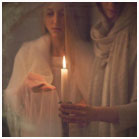|
KEREDWEN
Great Mother of Death and
Rebirth
(© Caillean)
Keredwen or
Cerridween is one of the most widely known
Goddesses of the Celtic pantheon
She
represents the archetype of the witch, the old
wisewoman, she who presides over death and
rebirth mysteries.
Her name
means Divine Door, as only by passing through
physical and initiatic death it is possible to
gain access to the knowledge of Mysteries and to
spiritual rebirth.
She is
associated with the waning, black moon, to the
darkness of winter and to the festival of
Samhain, over which she presides.
The cauldron
is her symbol:
the Earth’s
womb, the Great Mother who receives her children
to make them ready for a new cycle, just as the
seeds which lie asleep waiting for the spring
and carry in themselves the imprint of what they
were and what they will be. Keredwen teaches us
the mysteries of the neverending life cycles,
the secrets of Transformation, she whispers in
our minds what can be heard in the darkness of
the Cave, in winter harshness, when we immerse
ourselves in her cauldron down to the centre of
ourselves, between tears and life, between light
and darkness.
The witch is
present at once in mythologies worldwide: Death
and the secrets she keeps have from time
immemorial drawn mankind’s attention towards the
Great Initiatoress, the inescapability
of our mortal fate.
In the Greek
and Roman pantheon, we find Hecate, the Dark
Lady of the Crossroads, the painful
turning-points of our lives. She is usually in
the company of dogs, animals associated with
death as Guardians of the Door, psychopomps
guiding the soul’s journey to the Otherworld as
the well-known Anubis in Ancient Egypt.
In Egypt we
find the Great Isis who puts back together the
body parts of her slaughtered husband and gives
him new life.
In
Scandinavian mythology we have old Hel who
reigns in the Underworld.
In Mexico we
find the ‘Loba’, the she-wolf, who gathers the
bones of the dead and breathes life back into
them in her cave. Bones are considered a
widespread magical and symbolical element as
they represent what remains of the individual
and cannot be destroyed, a tangible sign that
something stays on, that the Grim Reaper does
not reap everything. It is out of bones that we
start building ourselves up again every time we
turn the page and open a new chapter in our
lives. Cyclically we face our inner darkness
once again, like the Loba we enter our personal
cave to pull back together our own torn up parts.
The Celtic
myth which tells about Keredwen at length can be
found in the Hanes Taliesin, a medieval Welsh
poem, first translated by Lady Guest at the end
of 1800 and included in the same collection
together with the 4 branches of the Mabinogion.
The legend
tells that Keredwen had two children:
The
beautiful Creidwy and the very ugly Afaggdu. In
order to give to the latter the knowledge of all
things in the world an to compensate his
deformity, the goddess brewed a magic potion
that had to be stirred for a year and a day in
her cauldron. When Keredwen had to absent
herself, she asked the young Gwion to stir the
potion in her place. One day Gwion burned his
finger with three drops of the hot liquid and,
by raising his finger to his mouth, he received
all the knowledge meant for Afaggdu. Afraid of
the wrath of the Goddess, Gwion ran away turning
into a hare, a salmon, a wren, and eventually a
grain of corn. Keredwen chased him in the form
of greyhound, then of otter and eventually of
hen. In this latter form, she swallowed poor
Gwion and, nine months later, gave birth to a
son, who was destined to become the great Bard
Taliesin. As he had conquered Knowledge at the
price of toil, suffering, transformation and
death. In the Goddess’ womb he had learnt the
price and the responsibility that knowledge
entails.
Keredwen
goes on calling her daughters through the
centuries, as even though life does not present
most of us with the rigours of long ago, death
and suffering remain constant phantoms in our
life. Keredwen teaches us the courage of
transformation, which is suffering and rebirth
at the same time: everything passes by and
resisting the flow is pointless, the lady of
death and rebirth urges us to carry on with
courage. Only if we are brave enough to look at
her in the face and hold her gaze will we find
the reflection of what we really are.
Traduzione a
cura di Abigail_derwen
| ![]()


